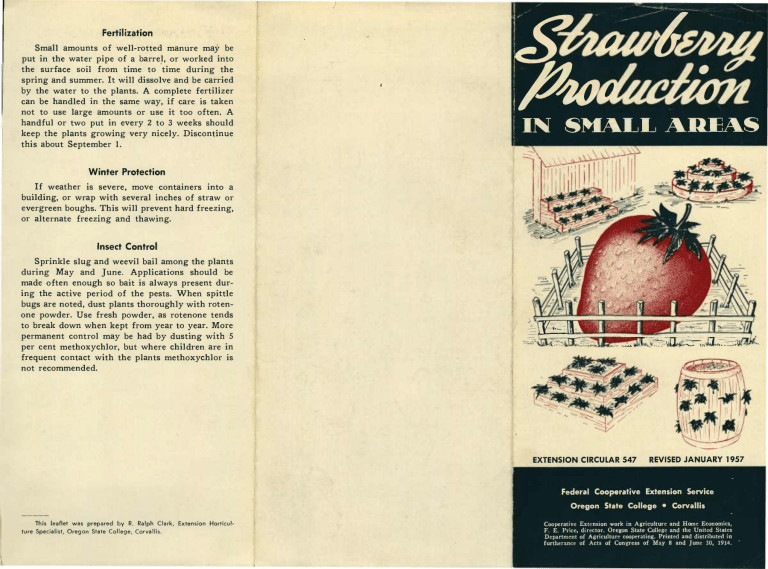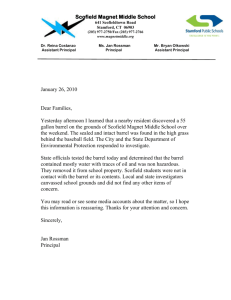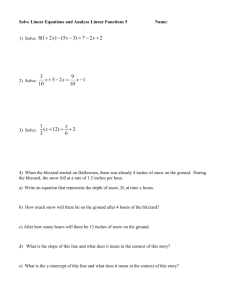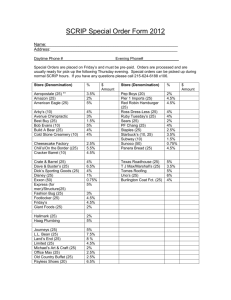Document 11050555

Fertilization
Small amounts of well-rotted manure may be put in the water pipe of a barrel, or worked into the surface soil from time to time during the spring and summer. It will dissolve and be carried by the water to the plants. A complete fertilizer can be handled in the same way, if care is taken not to use large amounts or use it too often. A handful or two put in every 2 to 3 weeks should keep the plants growing very nicely. Discontinue this about September 1.
Winter Protection
If weather is severe, move containers into a building, or wrap with several inches of straw or evergreen boughs. This will prevent hard freezing, or alternate freezing and thawing.
Insect Control
Sprinkle slug and weevil bail among the plants during May and June. Applications should be made often enough so bait is always present dur- ing the active period of the pests. When spittle bugs are noted, dust plants thoroughly with roten- one powder. Use fresh powder, as rotenone tends to break down when kept from year to year. More permanent control may be had by dusting with 5 per cent methoxychlor, but where children are in frequent contact with the plants methoxychlor is not recommended.
This leaflet was prepared by R. Ralph Clark, Extension Horticul- ture Specialist, Oregon State College, Corvallis.
Pwdactim
IN SMALL AREAS
ITPRE
^'-vSVii.-.o
5^il^v.;;^U^^r^.^..-^ r
?»-
EXTENSION CIRCULAR 547 REVISED JANUARY 1957
Federal Cooperative Extension Service
Oregon State College • Corvallis
Cooperative Extension work in Agriculture and Home Economics,
F. E. Price, director. Oregon State College and the United States
Department of Agriculture cooperating. Printed and distributed in furtherance of Acts of Congress of May 8 and June 30, 1914.
Sfocuv&evuf 'Pioductcon
IN SMALL AREAS
You don't need an acreage to grow strawberries.
Many city dwellers raise them for pleasure as well as for the fruit. Barrels, pyramids, and terraced beds are used for plantings of this type. If prop- erly handled, the plants bear fruit of good quality, and production is satisfactory. These small plant- ings can be quite ornamental, as well as productive.
The Strawberry Barrel
Use an oak barrel, or one of any other solid material. Bore two or three holes in the bottom of the barrel. A 1^4- or 2-inch auger is best for this purpose. With the same auger, bore a series of holes 10 to 12 inches apart in the sides of the barrel and 6 to 8 inches up from the bottom. About
6 to 8 inches above these, make another series of holes which are staggered about 3 inches from the holes below. Repeat this process until the last series of holes is 6 to 8 inches from the top. The barrel will last longer if the inside and freshly cut surfaces are painted with a copperized wood preservative. This material is available at stores handling spray supplies.
Turning the barrel
In order to have uniform growth and fruit pro- duction, it is best to have some method of turning the barrel easily. Turn frequently so that all plants get an equal amount of sunshine. This can be accomplished by mounting the barrel on a large set of casters or rollers, a turntable from an old clothes reel, or an old wheel mounted on an axle or pipe embedded in a plank or concrete base.
Filling the barrel
It is a good plan to place a small amount of gravel or broken crockery in the bottom of the barrel before starting to fill it with soil. This aids in the drainage of excess water.
STRAWBERRY BEOS FOR SMALL AREAS
PLANTS
6 INCH RETAINER
8 INCH BEOS C
TERRACED BED
—EMPTY
7—* «— —v—**—w**" PUNTS CROWN OUT, ROOTS SPREAD
SANDY LOAM SOIL-WELL PACKED
-* y X— —w M »—1 a-TILE ORWRFOWTEO CHMHEL
X * * —^< * *-
STRAWBERRY BARREL
r IJII
COARSE GRAVEL OR BROKEN CROCKERY
T T • HEAVY CASTERS OR ROLLERS
8 inch to K) inch beds
PLANTS IZ" APART fe"RETAIHER OF WOOD
METAL-CEMEMT-ETC.
PYRAMID BtD
A
As the soil is filled in, pack it rather firmly to prevent excessive settling when watered. When the soil reaches up to the first series of holes, place a young strawberry plant on the soil at each hole so the crown protrudes from the barrel. The roots are then spread and embedded in the soil. Follow the same procedure as the soil is built up to each series of holes. Finally, set four or five plants in the top of the barrel.
Watering and aeration
When the barrel is filled approximately one- third full of soil, provision must be made for watering and aerating this lower level of soil. This is done by placing on end in the center of the barrel a 3- or 4-inch tile, metal pipe, or wooden channel long enough to extend up even with the surface. There should be sufficient perforations to allow for the circulation of both air and water.
When planting is finished, thoroughly moisten the soil by running a hose into the open center, filling it with water. This should be done often enough to keep the soil fairly moist but not water- logged.
Pyramid and Terraced Beds
These beds are made in a wide variety of shapes. You can use metal, wood, concrete, or al- most any material for construction of the retain- ing walls. The beds usually are 8 to 12 inches wide and 6 to 8 inches above the one immediately be- low. One row of plants, spaced 10 to 12 inches apart, is used in each bed.
Terraced beds usually require a little more room than a barrel. They normally are more pro- ductive, and are easier to make and care for. Soil, fertilizer, location, and plants are the same as for the barrel.
Plants
Use large, healthy plants for best results. Trim off all large leaves before planting. Useful varie- ties include any of the everbearing plants recom- mended for regular field plantings in your area.
Early spring planting is preferred.
Soil
A good grade of sandy loam soil is best for this purpose. It should be well supplied with organic matter and fairly fertile for best results.
Fertilization
Small amounts of well-rotted manure may be put in the water pipe of a barrel, or worked into the surface soil from time to time during the spring and summer. It will dissolve and be carried by the water to the plants. A complete fertilizer can be handled in the same way, if care is taken not to use large amounts or use it too often. A handful or two put in every 2 to 3 weeks should keep the plants growing very nicely. Discontinue this about September 1.
Winter Protection
If weather is severe, move containers into a building, or wrap with several inches of straw or evergreen boughs. This will prevent hard freezing, or alternate freezing and thawing.
Insect Control
Sprinkle slug and weevil bail among the plants during May and June. Applications should be made often enough so bait is always present dur- ing the active period of the pests. When spittle bugs are noted, dust plants thoroughly with roten- one powder. Use fresh powder, as rotenone tends to break down when kept from year to year. More permanent control may be had by dusting with 5 per cent methoxychlor, but where children are in frequent contact with the plants methoxychlor is not recommended.
This leaflet was prepared by R. Ralph Clark, Extension Horticul- ture Specialist, Oregon State College, Corvallis.
Pwdactim
IN SMALL AREAS
ITPRE
^'-vSVii.-.o
5^il^v.;;^U^^r^.^..-^ r
?»-
EXTENSION CIRCULAR 547 REVISED JANUARY 1957
Federal Cooperative Extension Service
Oregon State College • Corvallis
Cooperative Extension work in Agriculture and Home Economics,
F. E. Price, director. Oregon State College and the United States
Department of Agriculture cooperating. Printed and distributed in furtherance of Acts of Congress of May 8 and June 30, 1914.



